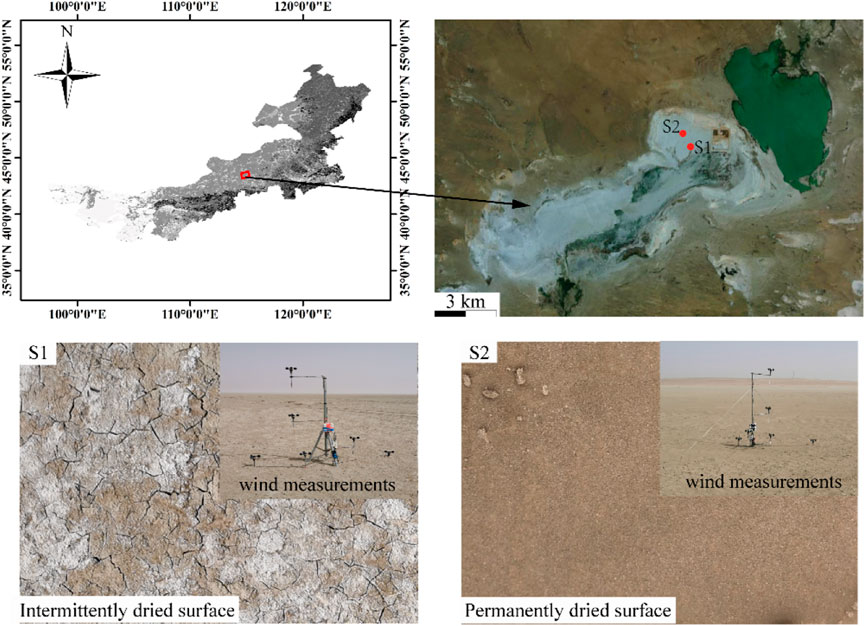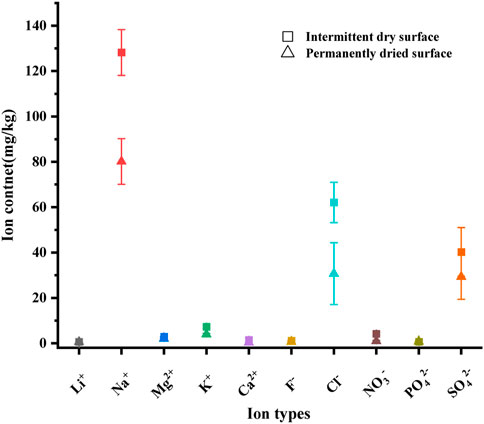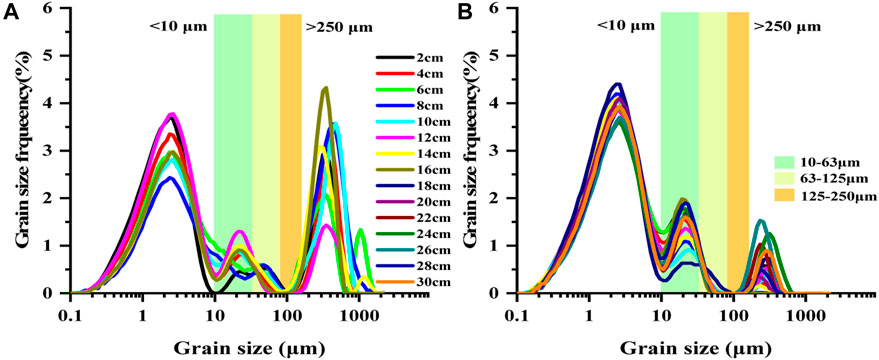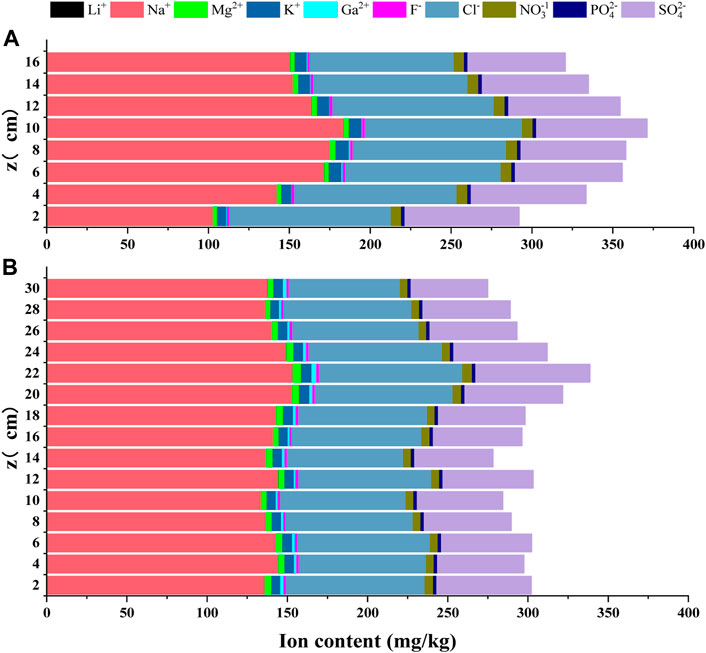- 1College of Desert Control Science and Engineering, Inner Mongolia Agricultural University, Hohhot, China
- 2Inner Mongolia Meteorological Institute, Hohhot, China
Semi-arid playas are important to grassland ecosystem species as an important source of global dust emissions. However, there is a lack of data on dust emissions during the different drying stages of grassland playas. In this study, we initially conducted the field experiments on two types of surfaces (intermittently dried and permanently dried) in playas located in semi-arid regions in northern China, and we measured dust emissions at five wind speeds in spring when wind erosion was frequent. The results showed that the intermittently dried surface was more prone to wind erosion, which was primarily due to the formation of a loose and fragile salt crust on the surface. In addition, the proportion of salt in the dust was higher than that for the permanently dried surfaces. Nevertheless, the total horizontal dust flux (1.13–2.3 g/cm2·min) from the intermittently dried surface was only 5%–15% that of the permanently dried surface (7.47–42.86 g/cm2·min). The dust content varied linearly with the height of the intermittently dried surface, and varied exponentially with the height of the permanently dried surface. The particles collected on the intermittently dried surface were larger (<63 μm) than those collected on the permanently dried surface (<10 μm), and the unit mass concentration of each ion (mainly Na+, Cl−, and SO42−) in the salt dust was also higher for the intermittently dried surface than for the permanently dried surface. Although salt dust was continuously released from the intermittently dried surface, the total amount released each time was limited. These results indicate that to attenuate the damage of salt dust storms, priority should be given to protecting permanently dried surfaces and reducing the supply of salt dust particles at the surface.
Introduction
Wind erosion caused by the drying of salt lakes is one of the sources of dust release in arid and semi-arid regions and even globally (Gill et al., 2002; Abuduwaili et al., 2010; Baddock et al., 2011; Motaghi et al., 2020; Van Pelt et al., 2020), accounting for about 30% of global dust emissions (Sweeney et al., 2016). According to current studies on dust emissions, landscapes that exist in semi-arid and arid regions such as the Gobi Desert (Wang et al., 2006b; Wang et al., 2008), salt and dry lakes, ephemeral stream depressions, seasonal marshes, and alluvial fans (Derbyshire et al., 1998), emit dust in different seasons (Varga, 2012). About 100–300 million tons of dust are emitted into the atmosphere each year (Varga et al., 2014). These landform units are commonly found in the western United States (Bowen and Johnson, 2015; Collins et al., 2018), North Africa (Prospero et al., 2002; Mahowald et al., 2006), Central Asia (Ziyaee et al., 2018), and northern China (Tao et al., 2020; Hao and Li, 2021). There are hundreds of lakes with areas of greater than 50 km2 in northern China, and under the drastic climate change and unreasonable human development, a large number of these lakes have shrunk and become dry lake beds. These lake beds are generally flatter and have lower slopes (Chun et al., 2017), no vegetation cover, and a surface composed of loose salt-rich sedimentary particles (Yang L.-R. et al., 2007; Liu et al., 2010). These surfaces are exposed to windy conditions year-round and are highly susceptible to wind erosion, leading to unavoidable air pollution and environmental problems in arid and semi-arid regions (Shao et al., 2011; Von Holdt et al., 2017). The chemical composition and particle size composition of salt dust storms are different from those of ordinary dust storms. Salt dust storms contain high concentrations of sulfate, chloride, and some harmful metal particles with strong adsorption (Abuduwaili et al., 2010), which usually lead to a decline in soil productivity, affect plant photosynthesis and cause respiratory diseases in animals and humans (Liu et al., 2010; Ziyaee et al., 2018). The chemical composition and particle size of the dried salt lake surface sediments also lead to the formation of aerosols that are suspended in the air for long periods, which have a serious impact on the local environment and can even be carried farther away before deposition, affecting a much wider area (Wang et al., 2012b). Therefore, the threat of such dust is greater than that of normal dust storms originating in the desert and Gobi regions. Based on previous studies, salinized particles play an important role in the atmospheric, climatic and biogeochemical cycles (Stout et al., 2009; Lee et al., 2012; Cheng et al., 2022), and the emission and dispersion of salt dust have become a hot research topic (Liu et al., 2010).
Numerous studies have been conducted on dry lakes using methods such as surface sampling (Shahabinejad et al., 2019), wind tunnel simulations (Liu et al., 2021), and remote sensing techniques (Cheng et al., 2022); however, these studies mainly focused on areas such as palm lakes in deserts, saline areas in degraded agricultural lands, and alluvial fans in the Gobi Desert (Gill et al., 2002; Yang L.-R. et al., 2007), as well as surface sediment characteristics. Wind erosion of dry lakes in grassland areas has been insufficiently studied, especially the horizontal flux transport of sediments at different heights. Grassland lakes, as an important part of grassland ecosystems, are now facing serious challenges, and a large number of these lakes have degraded and dried up (Meng et al., 2018). QeHan Lake dried up in 2002. Wind erosion of the surface consisting of loose salt-containing particles provides a sufficient source of sand, seriously damaging the local pasture and greatly affecting the lives and productivity of herders. However, due to the lack of pollution monitoring stations around the dry lakes in QeHan, there is limited information about how the area is directly affected by dust events. Therefore, we selected the dry salt lakes in QeHan, located on the Inner Mongolia Plateau, as the research area. Furthermore, we measured the surface sediment transport characteristics and wind erosion material in two different stages (intermittent drying and permanent drying) to reveal the wind erosion law in the different drying stages of grassland lakes. In addition, we aimed to provide reference data for soil wind erosion vacancies and desertification control of degraded lakes in grassland areas.
Materials and methods
Study area
QeHan Lake (114°45′–115°04′E, 43°22′–43°29′N) is a closed salt lakes located in the northern part of the Otindag sandy land region on the Inner Mongolia Plateau. QeHan relies on the Engel River for recharge, and the ecological environment is very fragile and sensitive to global climate change (Niu et al., 2005). Due to the influence of long-term high temperatures, the arid climate and excessive human economic activities during the past 40 years (Wang et al., 2006a; Yang X. et al., 2007), the grassland has been severely degraded, the sandy land has intensified, and the lakes have shrunk severely, making this one of the most serious areas of desertification in northern China (Chun et al., 2018). The study area is influenced by the East Asian summer monsoon and the East Asian winter monsoon (Tada et al., 2016; Li et al., 2017). The summer has maximum temperature of 39.1°C and winter has a minimum temperature of −42.2°C. The annual average temperature is 2.3°C. The annual precipitation is around 280 mm, and is mainly concentrated in July–September. The evaporation is around 2000 mm, the annual average wind speed is 3.5 m/s, and the number of windy days reaches 45 days. QeHan West Lake completely dried up in 2002, and a large area of the lake bed is now exposed. This area is rich in sand-sourced material, and high winds occur frequently every year, making it a huge source of sand and dust.
Method
The field data were collected on 25–26 April, 2021 in the area where strong dust storms occurred, and almost all of northern China received dust storms during this period, so our results are representative of the dust transport in this region.
Surface sampling
We randomly selected five locations and collected surface (0–5 cm) soil samples from two types of ground surfaces before the windy day on April 25, these two surfaces were defined according to the local river recharge. The first type of surface, seasonal alternation of wetting and drying as intermittently dried surface, and the other surface far away from the center of the lake and near the lake shore, the surface always keep dried loose situation as permanently dried surface. A total of 10 samples were collected. As shown in Figure 1, on the intermittently dried surface, a significant amount of salt frosts was attached to the top of the soil crust, while the permanently dried surface was composed of loose sediments without significant salt particles. The water content, ion contents, and particle size of the surface samples were measured to provide basic data for investigating wind and sand transport in the region.
Wind speed
The wind speed was measured five times using a three-cup anemometer at heights of 10, 30, 50, 100, and 200 cm at the two sampling sites, and the duration of each observation was up to 60 min.
Sediment transport
To determine the sediment transport characteristics on the playa surface, we used a homemade rotatable step sediment sampler to continuously measure the sediment transport within 50 cm, The sampler collected blowing sand in 2 cm × 2 cm sections. An electronic balance with a precision of .01 g was used to weight the collected sediment, and the field measurements were conducted five times during the occurrence of a severe sandstorm on 26 April 2021. Because the intermittently dry surface contained crusts and the sediment transport was limited, we combined the sand transport during periods one and two into one, and the sand transport during periods three, four, and five into a total of two sets of transport data. Five transport datasets were collected for the permanently dry surface.
Particle size and ion determination
We analyzed the particle size distribution and salt content of the collected sediments at the Key Laboratory of the State Forestry and Grassland Administration for the Conservation and Restoration of Desert Ecosystems, Inner Mongolia Agricultural University, using a German Flying laser grain size meter and a Swiss Aptar 930 ion chromatograph. One surface sample was collected from each site, and the samples collected at a height of 50 cm were analyzed. We classified the particle size into five classes: PM10 (<10 μm), clay and silt (<63 μm), very fine sand (63–125 μm), fine sand (125–250 μm) and sand (>250 μm); we analyzed the contents of 10 soluble salt ions: Li+, Na+, Mg2+, K+, Ca2+, F−, Cl−, NO3− PO42−, and SO42−.
Data processing
The vertical profile of uz, the horizontal wind velocity (m/s) at height z (cm), can be described by the law of the wall (Zhang et al., 2017):
where uz is the velocity at height z (m/s); K is the von Karman’s constant (.4); z is the measurement height (cm); a and b are regression coefficients; u* is the shear velocity (m/s); and z0 is the aerodynamic roughness (cm).
Mathematical models of the horizontal sediment flux were used to reflect the sand transport fluxes from the different surfaces. These models mainly focused on linear functions, exponential functions.
where QT is the total sediment transport rate at a height of 50 cm; qz is the sediment transport at height z in sediment collection chamber i. Q is the amount of sand transported in a certain height layer (g/cm2 min−1); z is the height (cm); a and b are the wind and sand circulation coefficients.
Result
Characteristics of surface soil
The surface characteristics of the two soils are presented in Table 1 and Figure 2. The intermittently dry surface was entirely composed of clay and chalk, and the permanently dry surface contained a small proportion of sand and gravel. The soil moisture content of the intermittently dry surface was slightly higher. The ions on both surfaces were mainly Na+, Cl−, and SO42−, and the contents of the other ions were low. The contents of all of the ions were greater on the intermittently dried surface than on the permanently dried surface (Liu et al., 2010).
Wind velocity during the field measurement periods
The surface characteristics affect the near-surface wind speed and also dust emissions, and the wind speed profiles in the study area all conform to a log-linear function (R2 > .95), and all these measurements in Figure 3 were performed during sediment transport events (i.e., sediment was being transported during the time of the measurements of u*) (Table 2). The roughness of the intermittently dried surfaces was calculated as .05–.07 cm, and it was only slightly affected by wind speed changes. The roughness of the permanently dried surfaces was .06–.37 cm and changed with the wind speed. Similarly, the friction velocity of the intermittently dried surface was .60–1.16 m/s, which was greater than that of the intermittently dried surfaces. The friction velocity increased with increasing wind speed from both types of surfaces. This indicates that the intermittent dried surface was more prone to wind erosion.
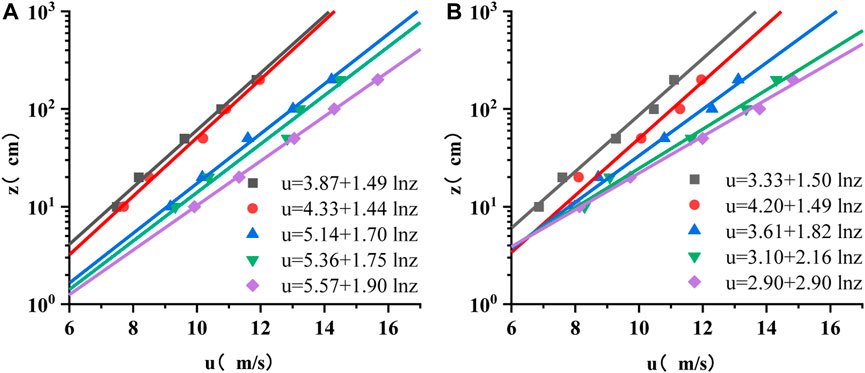
FIGURE 3. Five field observations of wind speed profiles on two types of surfaces, R2 > .95, p < .05.
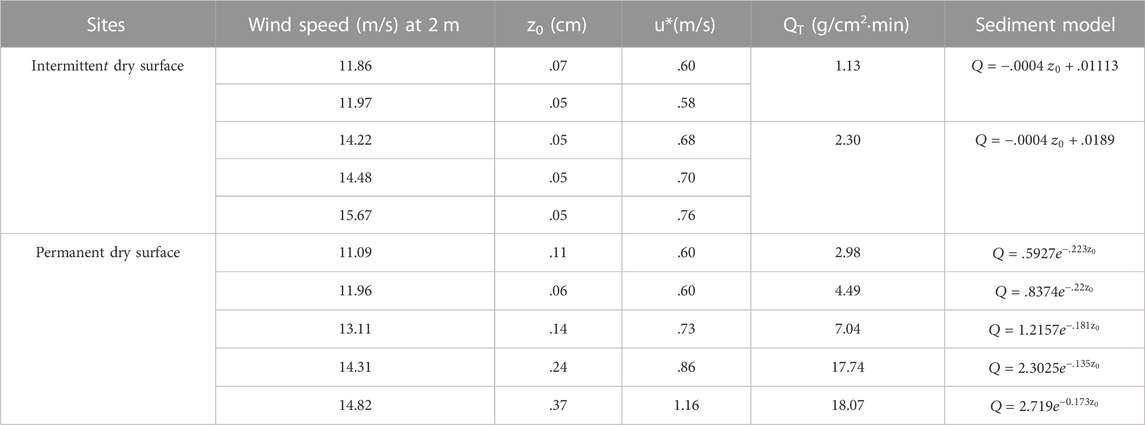
TABLE 2. Aerodynamic roughness length (z0, cm), calculated shear velocity (u*, m/s), and total transport rate (QT) at the two field measurement sites.
Horizontal sediment flux at different heights
The vertical distribution of the horizontal fluxes of the sediment from the intermittently dry and permanently dry surfaces at different wind speeds differed significantly (Figure 4). The measured dust fluxes from the permanently dry surfaces were 6.62–18.64 times higher than those from the intermittently dry surface (Figure 4A). Less dust was emitted from the intermittent drying surface in a lower height range, and it varied little with height. The dust transport varied linearly with wind speed for the intermittently dried surface (R2 > .92), while the dust emission from the permanently dried surface decreases varied significantly and exponentially with height at different wind speeds (R2 > .91) (Figure 4B; Table 2). This indicates that the erodible surface particle supply was an important factor controlling the horizontal dust flux at different heights, and the permanently dried surface provide more dust during salt dust storms.
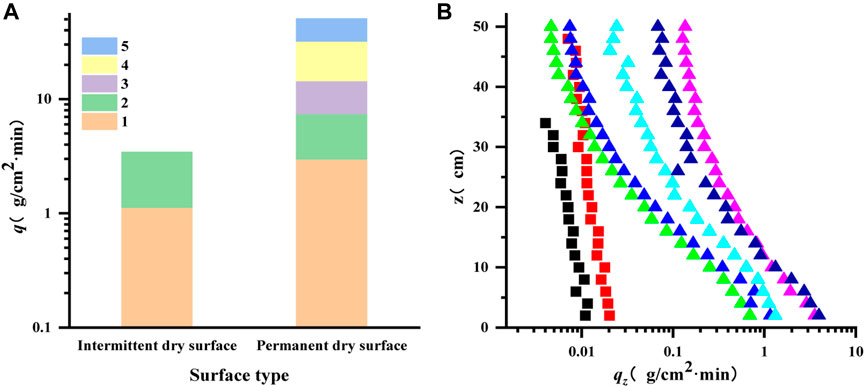
FIGURE 4. Horizontal sediment flux at different heights, (B) The squares represent salt dust emissions from the intermittently surface at wind speeds and the triangles represent salt dust emissions at five wind speeds.
Grain size frequency of aeolian sediment
Figure 5 shows the distribution characteristics of the sediments at different heights for both surfaces in the field. The frequency curves of the sediments were multi-peaked during the dust storms, and the particle size characteristics of both surfaces did not vary significantly with height. The main particles transported from the intermittently dried surface were clay <10 μm (49.93%–74.52%), followed by gravel >250 μm (mean of 22.56%) (Figure 5A), and the main particles transported from the permanently dried surface sediments were clay <10 μm (72.87%–87.83%), followed by 10–63 μm powder particles (mean of 15.61%) (Figure 5B). This indicates that the particles released from the intermittently dried surface were more dispersed and coarser than those released from the permanently dried surface. This means that the unstable secondary particles produced by the aggregation of fine salt particles were easily polished and decomposed during wind-blown sand activity and more suspended particles (<63 μm) were released.
Salt content of sediments
The water-soluble salt ions in the sediment transported from the two types of surfaces were emitted at different horizontal heights (Figure 6). The ions contained in the horizontal transport flux of the surface sediments in the study area were mainly Na+, Cl−, and SO42−, and the contents of the water-soluble ions such as Li+, Mg2+, K+, Ca2+, F−, NO3−, and PO42− were much lower than those of the above three ions. By comparing the sediment ion transport fluxes from the two surfaces, we found that the ion contents, as well as the total salinity, of the sediment released from the intermittently dried surface, were greater than that of the sediment released from the permanently dried surface at almost all height. The ion contents from the intermittently dried surface initially increased and then decreased (Figure 6A) within the measurable height (16 cm), and the highest salt content (182.93 mg/kg) was measured at a height of 10 cm. The ion contents from the permanently dried surface (Figure 6B) initially decreased within a height of 14 cm, increased from 14 to 22 cm, and decreased from 22 to 33 cm, and the maximum salt content was 152 mg/kg. This indicates that the horizontal sediment released from the intermittently dried surface contained a high concentration of salts and that the soluble salt particles were released before the soil particles during the drying process.
Discussion
Friction threshold velocity of surface characteristics
The physical characteristics of the surface, texture, and structure and the presence of undisturbed crust at the test site have a strong influence on both the friction velocity and roughness (Van Pelt et al., 2020). The friction velocity is generally considered to be the dominant factor controlling the horizontal deposition fluxes during wind erosion events and is generally influenced by surface roughness, soil moisture, soil particle size, and crusting (Buyantogtokh et al., 2021). In this study, we found that the frictional velocity and roughness of the intermittently dried surface (crusted) were smaller than those of the permanently dried (activated) surface, which is inconsistent with the common finding that crusting can increase the surface roughness and the frictional threshold velocity (Webb et al., 2016). We speculate that this inconsistency is related to the salt material on the surface, which was composed of sulfate, chloride, and sodium salts that formed a loose (McCord et al., 2001; Nield et al., 2016) and a fluffy thin layer of crust. These relatively low mass salt particles were more susceptible to wind erosion. When the loose particles on the surface were blown away, a relatively hard surface crust remained (Bu et al., 2015), so the friction velocity and roughness of the intermittently dried surface were smaller. The friction velocity and roughness are important factors controlling the horizontal sediment flux (Sankey et al., 2009; Baddock et al., 2011), but their importance varies in different systems (Webb et al., 2016). On the intermittently dried surface, there was a limited supply of salt dust, so the friction velocity and roughness played a secondary role in determining horizontal sediment flux (O’Brien and McKenna Neuman, 2012). The sediment flux can be increased by interference (Baddock et al., 2011), and changes in the size of sediment particles on the soil surface affect the friction velocity and roughness (Tegen et al., 2002).
Characteristics of surface dust emission
Grain size has a strong influence on dust emission and transport (Zhang et al., 2022). Particle removal from the surface and transport is influenced by surface wind forces and properties (Zobeck et al., 2013; Cheng et al., 2017). Finer soil particles generally either remain suspended in the air or are carried further away (Mahmoodabadi and Ahmadbeigi, 2012), while coarser particles remain on the soil surface (Mahmoodabadi and Cerdà, 2013), Based on analyzed of both the surface particles and the transported sediment particles, we found that the >250 μm particles collected from the intermittently dried land surface were not found in the surface sampling, so they must have come from the transit airflow. (Kok et al., 2012). showed that 63–500 μm particles move in a transmigratory manner at the surface, and this movement is extremely destructive to the surface, Sand-carrying winds carry gravel, causing the initial release of the fragile salt aggregates from the surface by polishing the crust surface. The limited supply of dust in the sand-carrying winds cause coarsening of the particles, but for the permanently dry surface, where the dust supply is sufficient, the effect of such limited particles on the dust coarsening is not significant. Alternatively, some of the larger particles in the sand-carrying winds produce a higher effective recovery factor on the rigid bed surface due to collision with the surface, and these particles can reach higher heights, whereas the permanently dried surface (loose particles) weakens kinetic energy and was converted to release of smaller particles to higher heights, so that there was no gravel on the intermittently dried surface and large particles are found in sediment transport, whereas permanently dried surface dust has fewer large particles (Kamath and Parteli, 2021).
The difference in the salt and dust emissions from the two surfaces clearly indicates that intermittently dried surfaces have limited material available for wind erosion due to the presence of crusts, greatly reducing the sediment carryover and thus weakening the intensity of the wind erosion and dust storms (Zhang et al., 2016), The functional relationship in the dust emission model of incompletely erodible bed (intermittently dried surface) was a linear function, and the slope is the same at different wind speeds, so that the flux of sediment was in a stable state, and the dust emission of completely erodible bed (permanently dried surface)was exponential model. This was consistent with Sandesh Kamath’s (Kamath et al., 2022) numerical simulation results and experimental conclusions. The number of sand available on the ground has a great influence on the dust flux (Kamath and Parteli, 2021). However, we found that the sediments released from the intermittently dry surfaces had higher salt concentrations than those released from the permanently dried surface, which corresponds to the salt concentrations of both surfaces. Evaporation is the main factor affecting the mineral composition of the surface in arid and semi-arid regions, and continuous dryness and wetness lead to the formation of mineral surfaces that are unstable and continuous dryness and wetness lead to the formation of mineral surfaces that are unstable and are changed by wind and precipitation, varying at different times and in different regions (Liu et al., 2010). Evaporation transports the solution to the soil surface. As water evaporates, ions remain on the surface and crystallize when the ion concentration was saturated (Dai et al., 2015; Altausen et al., 2019) where salt-rich surface was formed, and the frequency of intermittently dried surface water transport was higher than that of the permanently dried surface, so the surface salt concentration was higher. In general wind erosion mainly cause salt dispersion from the crustal surface (Dai et al., 2022); however, wind erosion and salt accumulation occur simultaneously, especially on intermittently dried surfaces, where water-soluble ions continuously replenish the salt loss due to wind erosion through epilimnion aggregation, providing an inexhaustible source for salt dust storms (Liu et al., 2010; Motaghi et al., 2020), so, the concentration of salt dust collected on intermittently dried surface was higher. We measured the salt concentration in the dust from the intermittently dried surface of 2.67%–5.25%. The results of the permanently dried surface releasing salt dust concentration of .03%–2% were similar to the results measured in the Wang wind tunnel (Wang et al., 2012a). Although intermittently dried surfaces continuously release high concentrations of salt dust, their salt dust emissions are only 5%–15% of those from permanently dried surfaces; thus, priority should be given to protecting permanently dried surfaces during the windy season to reduce dust emissions.
Conclusion
Our results confirm that the characteristics and mechanisms of surface sediment transport are different during the different phases of playa surface drying, which is crucial because lakes are important landscapes in northern China. Previous studies have shown that the Gobi Dessert is an important source of dust in northern China, and our results confirm that dry lakes are also major sources of dust, thus filling the previous knowledge gap. The main conclusions of this study are as follows.
1. The wind speed curve of the playa surface during the dust storm can be expressed as a logarithmic linear function. The friction velocity of the intermittently dried crust surface was .58–.76 m/s, and the aerodynamic roughness was .05–.07 cm. The friction velocity of the permanently dried surface was .6–1.16 m/s, and the aerodynamic roughness was .06–.37 cm. The fragile salt crust on the intermittently dried surface was more prone to wind erosion than the permanently dried surface.
2. During the observation period, the two sediment transport fluxes from the intermittently dried surface were 1.13 g/cm2·min and 2.3 g/cm2·min, respectively, and the sediment transport flux conformed to a linear function. The sediment transport fluxes from the permanently dried surface were 7.47 g/cm2·min and 42.86 g/cm2·min, respectively, and the sediment transport flux conformed to an exponential function. The salt dust released from the permanently dried surface was 6.62–18.64 times greater than that released from the intermittently dried surface.
3. The sand-carrying wind had a great influence on the salt particles released from the intermittently dried surface, but it had little effect on the soil particles released from the permanently dried surface. Although the two types of surface sediment particles were mainly <63μm, accounting for about 71.45%–96.02%, the salt dust particles released from the permanently dried surface were finer. The salt ions were mainly Na+, Cl−, and SO42-, and the concentrations of salt dust released from the intermittently surface were higher than that those of the permanently dry surface.
Our results showed that the transport rate and salt concentration of weathered sediments on the surface of a playa were very high, especially under strong wind conditions. Due to the limited height of our sand sampler, if particles were collected at a higher height, we believe that a better explanation for the emission of surface dust particles and the salt concentration could be obtained.
Data availability statement
The original contributions presented in the study are included in the article/supplementary material, further inquiries can be directed to the corresponding author.
Author contributions
SQ: Conceptualization, methodology, writing original draft; XR: Writing–review and editing; XD reviewed and revised the manuscript; ZM: Conceptualization, supervision, project administration.
Funding
This research was supported by the National Natural Science Foundation of China (42067015), and the Natural Science Foundation of Inner Mongolia Autonomous Region (2020MS03038), Desert Ecosystem Conservation and Restoration Innovation Team, and Improvement Innovation Team of Desertification Control (BR22-13-03).
Conflict of interest
The authors declare that the research was conducted in the absence of any commercial or financial relationships that could be construed as a potential conflict of interest.
Publisher’s note
All claims expressed in this article are solely those of the authors and do not necessarily represent those of their affiliated organizations, or those of the publisher, the editors and the reviewers. Any product that may be evaluated in this article, or claim that may be made by its manufacturer, is not guaranteed or endorsed by the publisher.
References
Abuduwaili, J., Liu, D., and Wu, G. (2010). Saline dust storms and their ecological impacts in arid regions. J. Arid Land 2, 144–150. doi:10.3724/sp.j.1227.2010.00144
Altausen, D., Ge, Y., Abuduwaili, J., Ma, L., Abdullaev, S., and Hofer, J. (2019). Lakes in arid land and saline dust storms. E3S Web Conf. 99, 01007. doi:10.1051/e3sconf/20199901007
Baddock, M. C., Zobeck, T. M., Van Pelt, R. S., and Fredrickson, E. L. (2011). Dust emissions from undisturbed and disturbed, crusted playa surfaces: Cattle trampling effects. Aeolian Res. 3, 31–41. doi:10.1016/j.aeolia.2011.03.007
Bowen, M. W., and Johnson, W. C. (2015). Holocene records of environmental change in High Plains playa wetlands, Kansas, US. Holocene 25, 1838–1851. doi:10.1177/0959683615591356
Bu, C., Zhao, Y., Hill, R. L., Zhao, C., Yang, Y., Zhang, P., et al. (2015). Wind erosion prevention characteristics and key influencing factors of bryophytic soil crusts. Plant Soil 397, 163–174. doi:10.1007/s11104-015-2609-z
Buyantogtokh, B., Kurosaki, Y., Tsunekawa, A., Tsubo, M., Gantsetseg, B., Davaadorj, A., et al. (2021). Effect of stones on the sand saltation threshold during natural sand and dust storms in a stony desert in Tsogt-Ovoo in the Gobi Desert, Mongolia. J. Arid Land 13, 653–673. doi:10.1007/s40333-021-0072-7
Cheng, H., Liu, C., Li, J., Zou, X., Liu, B., Kang, L., et al. (2017). Wind erosion mass variability with sand bed in a wind tunnel. Soil Tillage Res. 165, 181–189. doi:10.1016/j.still.2016.08.013
Cheng, Y.-B., Dickey, H., Yimam, Y. T., Schmid, B., Paxton, B., Schreuder, M., et al. (2022). Land surface parameterization at exposed playa and desert region to support dust emissions estimates in southern California, United States. Remote Sens. 14, 616. doi:10.3390/rs14030616
Chun, X., Su, R., Liu, J., Liang, W., Yong, M., and Ulambadrakh, K. (2017). Climatic implications on variations of Qehan Lake in the arid regions of Inner Mongolia during the recent five decades. Environ. Monit. Assess. 189, 14. doi:10.1007/s10661-016-5721-5
Chun, X., Yong, M., Liu, J., and Liang, W. (2018). Monitoring land cover change and its dynamic mechanism on the QeHan Lake basin, inner Mongolia, North China, during 1977–2013. Environ. Monit. Assess. 190, 205. doi:10.1007/s10661-018-6582-x
Collins, J. D., Gill, T. E., and Langford, R. (2018). Characterizing formation processes of Rimrock Lake, a Late Pleistocene-Holocene playa, Harney Basin, south-eastern Oregon, USA, using an end-member mixing analysis. J. Quat. Sci. 33, 721–737. doi:10.1002/jqs.3048
Dai, J., Zhang, G., Liu, L., Shi, P., Zhang, H., Han, X., et al. (2022). Effects of efflorescence and subflorescence by different salts on soil physical properties and aeolian erosion. Catena 215, 106323. doi:10.1016/j.catena.2022.106323
Dai, S., Shin, H., and Santamarina, J. C. (2015). Formation and development of salt crusts on soil surfaces. Acta Geotech. 11, 1103–1109. doi:10.1007/s11440-015-0421-9
Derbyshire, E., Meng, X., and Kemp, R. A. (1998). Provenance, transport and characteristics of modern aeolian dust in Western Gansu Province, China, and interpretation of the Quaternary loess record. Quat. loess Rec. 39, 497–516. doi:10.1006/jare.1997.0369
Gill, T. E., Gillette, D. A., Niemeyer, T., and Winn, R. T. (2002). Elemental geochemistry of wind-erodible playa sediments, Owens Lake, California. Owens Lake, Calif. 189, 209–213. doi:10.1016/s0168-583x(01)01044-8
Hao, S., and Li, F. (2021). Water sources of the typical desert vegetation in Ebinur Lake basin. Acta Geogr. Sin. 76, 1649–1661. doi:10.1007/s11442-022-1987-4
Kamath, S., and Parteli, E. J. (2021). Toward a large-scale particle-based parallel simulator of Aeolian sand transport, including a model for mobile sand availability. EPJ Web Conf. 249, 13004. doi:10.1051/epjconf/202124913004
Kamath, S., Shao, Y., and Parteli, E. J. R. (2022). Scaling laws in aeolian sand transport under low sand availability. Geophys. Res. Lett. 49, e2022GL097767. doi:10.1029/2022gl097767
Kok, J. F., Parteli, E. J., Michaels, T. I., and Karam, D. B. (2012). The physics of wind-blown sand and dust. Rep. Prog. Phys. 75, 106901. doi:10.1088/0034-4885/75/10/106901
Lee, J. A., Baddock, M. C., Mbuh, M. J., and Gill, T. E. (2012). Geomorphic and land cover characteristics of aeolian dust sources in West Texas and eastern New Mexico, USA. Aeolian Res. 3, 459–466. doi:10.1016/j.aeolia.2011.08.001
Li, X., Cheng, H., Tan, L., Ban, F., Sinha, A., Duan, W., et al. (2017). The East Asian summer monsoon variability over the last 145 years inferred from the Shihua Cave record, North China. Sci. Rep. 7, 7078. doi:10.1038/s41598-017-07251-3
Liu, B., Wang, Z., Niu, B., and Qu, J. (2021). Large scale sand saltation over hard surface: A controlled experiment in still air. J. Arid Land 13, 599–611. doi:10.1007/s40333-021-0104-3
Liu, D., Abuduwaili, J., Lei, J., Wu, G., and Gui, D. (2010). Wind erosion of saline playa sediments and its ecological effects in Ebinur Lake, Xinjiang, China. Environ. Earth Sci. 63, 241–250. doi:10.1007/s12665-010-0690-4
Mahmoodabadi, M., and Ahmadbeigi, B. (2012). Dry and water-stable aggregates in different cultivation systems of arid region soils. Arabian J. Geosciences 6, 2997–3002. doi:10.1007/s12517-012-0566-x
Mahmoodabadi, M., and Cerdà, A. (2013). WEPP calibration for improved predictions of interrill erosion in semi-arid to arid environments. Geoderma 204-205, 75–83. doi:10.1016/j.geoderma.2013.04.013
Mahowald, N. M., Muhs, D. R., Levis, S., Rasch, P. J., Yoshioka, M., Zender, C. S., et al. (2006). Change in atmospheric mineral aerosols in response to climate: Last glacial period, preindustrial, modern, and doubled carbon dioxide climates. J. Geophys. Res. Atmos. 111. doi:10.1029/2005jd006653
Mccord, T. B., Orlando, T. M., Teeter, G., Hansen, G. B., Sieger, M. T., Petrik, N. G., et al. (2001). Thermal and radiation stability of the hydrated salt minerals epsomite, mirabilite, and natron under Europa environmental conditions. J. Geophys. Res. Planets 106, 3311–3319.
Meng, Z., Dang, X., Gao, Y., Ren, X., Ding, Y., and Wang, M. (2018). Interactive effects of wind speed, vegetation coverage and soil moisture in controlling wind erosion in a temperate desert steppe, Inner Mongolia of China. J. Arid Land 10, 534–547.
Motaghi, F. A., Hamzehpour, N., Abasiyan, S. M. A., and Rahmati, M. (2020). The wind erodibility in the newly emerged surfaces of Urmia Playa Lake and adjacent agricultural lands and its determining factors. Catena 194, 104675. doi:10.1016/j.catena.2020.104675
Nield, J. M., Mckenna Neuman, C., O’brien, P., Bryant, R. G., and Wiggs, G. F. S. (2016). Evaporative sodium salt crust development and its wind tunnel derived transport dynamics under variable climatic conditions. Aeolian Res. 23, 51–62. doi:10.1016/j.aeolia.2016.09.003
Niu, S. L., Jiang, G. M., Wan, S. Q., Liu, M. Z., Gao, L. M., and Li, Y. G. (2005). Ecophysiological acclimation to different soil moistures in plants from a semi-arid sandland. J. Arid Environ. 63, 353–365. doi:10.1016/j.jaridenv.2005.03.017
O'brien, P., and Mckenna Neuman, C. (2012). A wind tunnel study of particle kinematics during crust rupture and erosion. Geomorphology 173-174, 149–160. doi:10.1016/j.geomorph.2012.06.005
Prospero, J. M., Ginoux, P., Torres, O., Nicholson, S. E., and Gill, T. E. (2002). Environmental characterization of global sources of atmospheric soil dust identified with the nimbus 7 total ozone mapping spectrometer (toms) absorbing aerosol product. Rev. Geophys. 40, 2-1–2-31231. doi:10.1029/2000rg000095
Sankey, J. B., Germino, M. J., and Glenn, N. F. (2009). Relationships of post-fire aeolian transport to soil and atmospheric conditions. Aeolian Res. 1, 75–85. doi:10.1016/j.aeolia.2009.07.002
Shahabinejad, N., Mahmoodabadi, M., Jalalian, A., and Chavoshi, E. (2019). The fractionation of soil aggregates associated with primary particles influencing wind erosion rates in arid to semiarid environments. Geoderma 356, 113936. doi:10.1016/j.geoderma.2019.113936
Shao, Y., Wyrwoll, K.-H., Chappell, A., Huang, J., Lin, Z., Mctainsh, G. H., et al. (2011). Dust cycle: An emerging core theme in Earth system science. Aeolian Res. 2, 181–204. doi:10.1016/j.aeolia.2011.02.001
Stout, J. E., Warren, A., and Gill, T. E. (2009). Publication trends in aeolian research: An analysis of the Bibliography of Aeolian Research. Geomorphology 105, 6–17. doi:10.1016/j.geomorph.2008.02.015
Sweeney, M. R., Zlotnik, V. A., Joeckel, R. M., and Stout, J. E. (2016). Geomorphic and hydrologic controls of dust emissions during drought from Yellow Lake playa, West Texas, USA. J. Arid Environ. 133, 37–46. doi:10.1016/j.jaridenv.2016.05.007
Tada, R., Zheng, H. B., and Clift, P. D. (2016). Evolution and variability of the Asian monsoon and its potential linkage with uplift of the Himalaya and Tibetan Plateau. Prog. Earth Planet. Sci. 3, 4. doi:10.1186/s40645-016-0080-y
Tao, S., Fang, J., Ma, S., Cai, Q., Xiong, X., Tian, D., et al. (2020). Changes in China’s lakes: Climate and human impacts. Natl. Sci. Rev. 7, 132–140. doi:10.1093/nsr/nwz103
Tegen, I., Harrison, S. P., Kohfeld, K., Prentice, I. C., Coe, M., and Heimann, M. (2002). Impact of vegetation and preferential source areas on global dust aerosol: Results from a model study. J. Geophys. Res. Atmos. 107, AAC 14-21. doi:10.1029/2001jd000963
Van Pelt, R. S., Tatarko, J., Gill, T. E., Chang, C., Li, J., Eibedingil, I. G., et al. (2020). Dust emission source characterization for visibility hazard assessment on Lordsburg Playa in Southwestern New Mexico, USA. Geoenvironmental Disasters 7, 34. doi:10.1186/s40677-020-00171-x
Varga, G. J. H. G. B. (2012). Spatio-temporal distribution of dust storms-a global coverage using. NASA TOMS aerosol Meas. 61, 275.
Varga, G., Ujvari, G., and Kovacs, J. (2014). Spatiotemporal patterns of saharan dust outbreaks in the mediterranean basin. Aeolian Res. 15, 151–160. doi:10.1016/j.aeolia.2014.06.005
Von Holdt, J., Eckardt, F., and Wiggs, G. (2017). Landsat identifies aeolian dust emission dynamics at the landform scale. Remote Sens. Environ. 198, 229–243. doi:10.1016/j.rse.2017.06.010
Wang, X., Chen, F., and Dong, Z. (2006a). The relative role of climatic and human factors in desertification in semiarid China. Glob. Environ. Change 16, 48–57. doi:10.1016/j.gloenvcha.2005.06.006
Wang, X., Hua, T., Zhang, C., Lang, L., and Wang, H. (2012a). Aeolian salts in Gobi deserts of the Western region of Inner Mongolia: Gone with the dust aerosols. Atmos. Res. 118, 1–9. doi:10.1016/j.atmosres.2012.06.003
Wang, X., Hua, T., Zhang, C., Qian, G., and Luo, W. (2012b). Salts in the clay playas of China’s arid regions: Gone with the wind. Environ. Earth Sci. 68, 623–631. doi:10.1007/s12665-012-1765-1
Wang, X., Xia, D., Wang, T., Xue, X., and Li, J. (2008). Dust sources in arid and semiarid China and southern Mongolia: Impacts of geomorphological setting and surface materials. Geomorphology 97, 583–600. doi:10.1016/j.geomorph.2007.09.006
Wang, X., Zhou, Z., and Dong, Z. (2006b). Control of dust emissions by geomorphic conditions, wind environments and land use in northern China: An examination based on dust storm frequency from 1960 to 2003. Geomorphology 81, 292–308. doi:10.1016/j.geomorph.2006.04.015
Webb, N. P., Galloza, M. S., Zobeck, T. M., and Herrick, J. E. (2016). Threshold wind velocity dynamics as a driver of aeolian sediment mass flux. Aeolian Res. 20, 45–58. doi:10.1016/j.aeolia.2015.11.006
Yang, L.-R., Yue, L.-P., and Li, Z.-P. (2007a). The influence of dry lakebeds, degraded sandy grasslands and abandoned farmland in the arid inlands of northern China on the grain size distribution of East Asian aeolian dust. Environ. Geol. 53, 1767–1775. doi:10.1007/s00254-007-0782-y
Yang, X., Ding, Z., Fan, X., Zhou, Z., and Ma, N. (2007b). Processes and mechanisms of desertification in northern China during the last 30 years, with a special reference to the Hunshandake Sandy Land, eastern Inner Mongolia. Catena 71, 2–12. doi:10.1016/j.catena.2006.10.002
Zhang, Z., Dong, Z., Li, J., Qian, G., and Jiang, C. (2016). Implications of surface properties for dust emission from gravel deserts (gobis) in the Hexi Corridor. Geoderma 268, 69–77. doi:10.1016/j.geoderma.2016.01.011
Zhang, Z., Dong, Z., and Wu, G. (2017). Field observations of sand transport over the crest of a transverse dune in northwestern China Tengger Desert. Soil Tillage Res. 166, 67–75. doi:10.1016/j.still.2016.10.010
Zhang, Z., Zhang, Y., and Pan, K. (2022). Characteristics of Aeolian sediments transported above a gobi surface. Characteristics of Aeolian sediments transported above a gobi surface. Atmos. Chem. Phys. doi:10.5194/acp-2022-485
Ziyaee, A., Karimi, A., Hirmas, D. R., Kehl, M., Lakzian, A., Khademi, H., et al. (2018). Spatial and temporal variations of airborne dust fallout in Khorasan Razavi Province, Northeastern Iran. Geoderma 326, 42–55. doi:10.1016/j.geoderma.2018.04.010
Keywords: grassland playa, wind erosion, salt crust, salt dust, desertification of land
Citation: Qi S, Ren X, Dang X and Meng Z (2023) Mechanisms of dust emissions from lakes during different drying stages in a semi-arid grassland in northern China. Front. Environ. Sci. 10:1110679. doi: 10.3389/fenvs.2022.1110679
Received: 29 November 2022; Accepted: 23 December 2022;
Published: 06 January 2023.
Edited by:
Kaibo Wang, Institute of Earth Environment (CAS), ChinaReviewed by:
Baicheng Niu, Qinghai Normal University, ChinaEric Josef Ribeiro Parteli, University of Duisburg-Essen, Germany
Copyright © 2023 Qi, Ren, Dang and Meng. This is an open-access article distributed under the terms of the Creative Commons Attribution License (CC BY). The use, distribution or reproduction in other forums is permitted, provided the original author(s) and the copyright owner(s) are credited and that the original publication in this journal is cited, in accordance with accepted academic practice. No use, distribution or reproduction is permitted which does not comply with these terms.
*Correspondence: Zhongju Meng, bWVuZ3pob25nanVAMTI2LmNvbQ==
 Shuai Qi1
Shuai Qi1 Xiaohong Dang
Xiaohong Dang Zhongju Meng
Zhongju Meng